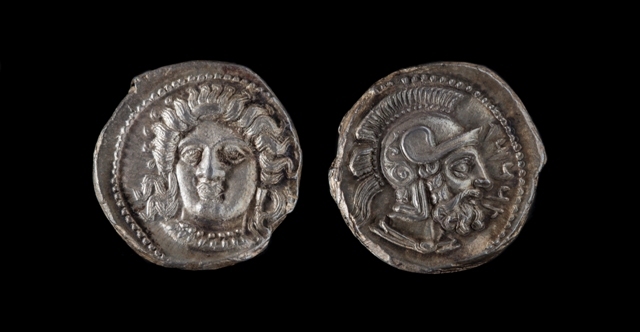Tarsus, Cilicia, Silver Stater
Dublin Core
Title
Tarsus, Cilicia, Silver Stater
Subject
Tarsus, Cilicia (Turkey). Silver Stater, ca. 378-372 BCE.
OBVERSE: Facing head of a goddess or nymph, inclined to left, wearing a sphendone, multi-pendant necklace, and earrings, all set in dotted border.
REVERSE: DAMATAS in Aramaic characters. Bearded male head (Ares?) wearing an Attic helmet with three-part crest and movable double visor, facing to the right, set in dotted border. Aramaic inscription in right field: TRKMW, i.e., Tarkamuwa, the Persian satrap known to the Greeks as Damates.
OBVERSE: Facing head of a goddess or nymph, inclined to left, wearing a sphendone, multi-pendant necklace, and earrings, all set in dotted border.
REVERSE: DAMATAS in Aramaic characters. Bearded male head (Ares?) wearing an Attic helmet with three-part crest and movable double visor, facing to the right, set in dotted border. Aramaic inscription in right field: TRKMW, i.e., Tarkamuwa, the Persian satrap known to the Greeks as Damates.
Description
Damates (ca. 407 - 362 BCE) was the satrap (Persian governor) of both Cappadocia and Cicilia under the Persian Great King Artaxerxes II (405-359 BCE). Proving his worth through many bloody battles, Damates became the most powerful satrap of Artaxerxes. Damates later rebelled and led the great Satrapal revolt. The revolt took almost ten years to quell and Damates was assassinated in 362 BCE.
Before the revolt, around 378 BCE, another satrap, Pharnabazus of Dascylium, was ordered to invade Egypt, which had recently freed itself of Persian rule. Pharnabazus failed around 373 BCE and another order to invade was given to Damates. In order to pay for these expeditions, the two satraps minted nearly identical coins, only distinguishable by the inscription. The woman on the front is clearly inspired by the famous representations of the nymph Arethusa created by the artist Kimon for the coins of Syracuse, but her identity on these coins is a mystery. The back simply shows a helmeted warrior, possibly Ares (god of war). These designs were likely supposed to appeal to the thousands of Greek mercenaries hired during these Egyptian campaigns.
Before the revolt, around 378 BCE, another satrap, Pharnabazus of Dascylium, was ordered to invade Egypt, which had recently freed itself of Persian rule. Pharnabazus failed around 373 BCE and another order to invade was given to Damates. In order to pay for these expeditions, the two satraps minted nearly identical coins, only distinguishable by the inscription. The woman on the front is clearly inspired by the famous representations of the nymph Arethusa created by the artist Kimon for the coins of Syracuse, but her identity on these coins is a mystery. The back simply shows a helmeted warrior, possibly Ares (god of war). These designs were likely supposed to appeal to the thousands of Greek mercenaries hired during these Egyptian campaigns.
Source
Gift of James and Aneta McIntyre, Hallie Ford Museum of Art, Salem, OR. 2006.010.008
Date
ca. 378-372 BCE.
Rights
Hallie Ford Museum of Art
Format
1.070 cm
21.200 gr
21.200 gr
Language
Aramaic
Type
Persian
Identifier
Persian nymph
Coverage
This item is can be viewed on the Hallie Ford Museum of Art's website.
Citation
“Tarsus, Cilicia, Silver Stater,” Hallie Ford Museum of Art Exhibits, accessed January 3, 2026, https://library.willamette.edu/hfma/omeka/items/show/59.
